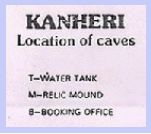Guess what this is!
This is a map of the Buddhist caves at Kanheri. A bit like a rabbit warren, don't you think? Kanheri grew over a period of eight centuries to become one of Western India's largest Buddhist monk settlements. As it grew, the monks carved out more and more caves, until the entire hill was dotted with prayer halls, sleeping quarters and water tanks. Here's the key to the map. As you can see there are over a hundred caves - with lots of tanks and cisterns to store water.
 If you ever get to Kanheri, use the map to figure out how to get from cave to cave. The starting point is the Booking Office, which you can see illustrated at the bottom of the map.
If you ever get to Kanheri, use the map to figure out how to get from cave to cave. The starting point is the Booking Office, which you can see illustrated at the bottom of the map.It can be interesting. One overseas couple who tried it had this to say: "The map in the guide book looked bizarre. It was simply a series of dots and numbers that resembled a child's connect-the-dots puzzle. However, like so many other systems in India that seem totally illogical or unintelligible on the surface, those amazing little numbers helped us find all the caves we wanted to see in that honeycombed ravine. That was just as well, because there was no one to ask for directions!".
Kanheri is set well inside Sanjay Gandhi National Park, so it is calm and quiet and green, very different from Bombay's usual bustle and noise. See for yourself.

0 comments:
Post a Comment